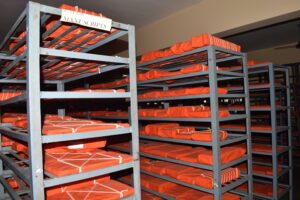Faculty of Language
Department of Manuscriptology

Introduction
The Department of Manuscriptology was established in 1996. The Department is making efforts to collect all kinds of manuscripts and protect them to know our past. The activity involves four stages: 1. Collection of Manuscripts 2. Editing 3.Studying and 4.Publishing. Now the department has plans to digitalize the present and also the future collection. The department has in its collection more the 5,000 valuable manuscripts in Kannada, Tamil, Telugu, Malayalam, Marathi and Sanskrit scripts. The collection includes valuable works like Nanni’s Bharata Halayudha Stotra, Kumara Sambhava, Shivadi kyaratnavali and an interpretation of Margha Kavya. Rare manuscripts like Sanskrit language but Kannada script; Kannada language but Telugu script; Telugu language Kannada scripts are also in the collection and some of them are with colourful illustrations.
These manuscripts are important in reconstructing the history of not only of Karnataka but of south India. Out of 5,000 Manuscripts 2000 Manuscripts have been catalogued and published in 5 volumes as descriptive catalogue. The Catalogue contains details about the scribe, script, writer and the patron etc. We have published some of them in print form like Vishnusharmana Panchatantra, Hiriyannakaviya HayaRatnashreni, Chidanandavadhuta Charitrya, Gundabramyya Sahitya, which were hitherto unavailable. Department also offers Research programs.
The Department is obtaining the assistance of scholars in the respective field for editing, publishing and study of the texts. The prime aims and objective of the Department is to recreate the culture importance of the south Indian writing tradition through the manuscripts.
- From the study of manuscripts we can identify the scripts, scriptwriters, language and the model of styles of scripts. The aim of our Department is to meaningfully study such aspects.
- Through the collection of the traditional knowledge materials like (Palm leaves, supplier, illustrator etc.) manuscripts the cultural importance behind them may be studied
- The Department has taken up the special work of collecting and editing study of such work (We have focus unpublished and cultural importance manuscripts).
- The same model is extended to teaching levels while at the University level, specially to the M.A.,Ph.D. (Kannada) composite classes and department level for M.Phil and Ph.D. Classes and diploma classes teaching work is taken up.
- Manuscripts laboratory very importance unit of the Department. in the laboratory Manuscripts, maps, pictures, files etc. Through this we dream to establish model manuscripts collection importance information in laboratory.
Vision Statement of the Department
- To be the repository of all manuscripts either in physical format or in digital format
- To cultivate the skills of preserving, reading, editing manuscripts
- To enrich Kannada literature through bringing out hitherto unpublished manuscripts in print format
- To conduct research out to bring out the hidden dimensions of various cultural/textual transactions in ancient and medieval period to explore history of Karnataka/South India.
Mission Statement of the Department
- Enhance the collection of the Manuscript library (more than 5,000 manuscripts are already available)
- To have digital catalogue, along with the digitalized manuscript attached to it
- To increase the number of programmes organised to create awareness about preserving manuscripts and training programme to decipher the manuscripts with the help of National Mission for Manuscripts, New Delhi.
- To encourage studies of manuscripts as texts and also as institutions
Uniqueness of the Department
Digitalization of Manuscripts : This is one of the significant projects of the department. The department has already begun the work of e preserving the six thousand manuscripts in the Library with modern technology. Special lecture Programme Inviting experienced scholars in Manuscripts and Old Kannada field have been organised. The department aims to reconstruct Old Kannada Literature and Culture through the Manuscripts.
Department Profile
Major Programs/Courses of the Department
Ph.D. in Manuscriptology
M.Phil. in Manuscriptology
PG Diploma in Manuscriptology
Courses offered to M.A., Ph.D. in Kannada
Syllabus
Details of the faculties :
| Photo | Name |
|---|---|
 | Dr. V.S. Badiger Designation: Senior Professor and Chairperson Department of Manuscriptology Email ID : vsbadiger172@gmail.com Phone No : 94488 45789 Highest Qualification : Ph D. Area of Specialization : Manuscriptology Profile: click here to view Vidwan Account : click here to view |
 | Dr. F.T.Hallikeri Designation: Senior Professor, Dean, Faculty of Language Email ID : hallikerift@gmail.com Phone No : 9448184022 Highest Qualification : Ph D. Area of Specialization : Manuscriptology Profile: click here to view Vidwan Account : click here to view |
 | Dr. S.S.Angadi Designation: Senior Professor Department of Manuscriptology Email ID : Phone No : 99455 98224 Highest Qualification : Ph D. Area of Specialization : Linguistics, Manuscriptology Profile: click here to view Vidwan Account : click here to view |
 | Dr.S.R.Channaveerappa Designation: Senior Professor Department of Manuscriptology Email ID : srchannaveerappa@gmail.com Phone No : 9480728409 Highest Qualification : Ph D. Area of Specialization : Linguistics, Manuscriptology Profile: click here to view Vidwan Account : click here to view |
Major Research Projects
Major Contribution of the Department :
- The department apartment collecting, preserving and studying manuscripts is also organising the following:
- Annual Conferences of Manuscriptology: It is one of the important forums for scholars working in Manuscriptology to come together to discuss and share new research in the field.
- Save Historical Heritage: To create awareness in youth, students and general public.
- Old Kannada Teaching Programme: To train the interested in reading Old Kannada.
- Haleya Honnu: A department level program to discuss issues related to Old Kannada literature.
- In collaboration with NMM (National Manuscripts Mission) the department has taken up the task of surveying the collection of manuscripts in North Karnataka.
Conference/Seminars/Workshops/Endowment Lectures etc :
Details of Publications, Books and Research Articles (with ISBN,ISSN and without ISBN, ISSN) :
Contact Us
Dr. Ravindranath K.
Professor and Chairperson
Department of Manucriptology
Kannada University, Hampi
Vidyaranya – 583276
Email:drravindranath62@gmail.com
Mobile : 9448261946




